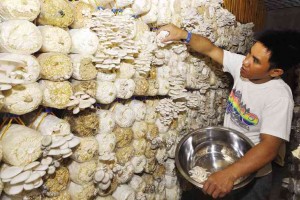
Rindo Natiguing, above, a pastor of the Crown of Glory Christian Fellowship, harvests mushrooms from one of two establishments built by Chrisanto Balila in Villasis town, Pangasinan.
VILLASIS, Pangasinan—In his spare time, Chrisanto Balila would visit supermarkets and restaurants in Pangasinan province and in Baguio City to market the fresh oyster mushrooms and pickled mushrooms he produces in his backyard here.
When he had his first harvest a year ago, Balila introduced the fresh mushrooms to his neighbors in Barangay Zone IV and to friends in Villasis, a first-class municipality (annual income: at least P55 million) of some 60,000.
The mushrooms, which he sold for P150 a kilo, were instant hits. Soon, people would come to his house every day to buy.
“We want consumers to find our products in supermarket shelves. And we are getting there,” says Balila, 42, who is also the agricultural officer of neighboring Sto. Tomas town.
Balila started to grow mushrooms for his church, Crown Glory Christian Fellowship, as a livelihood project for its members.
Mushrooms are a healthy food, he says, and production is profitable.
Unlike vegetables and fruits, mushrooms continue to be rich in vitamins and minerals even if these go through processing, Emily
At right, two men sort out the mushrooms to be sold at supermarkets and restaurants in Pangasinan and Baguio City.
Soriano of the Central Luzon Integrated Agricultural Research Center says in an article posted on the Bureau of Agricultural Research website (www.bar.gov.ph).
Ninety percent of mushrooms consumed in the country are imported, averaging 150 metric tons a year, Soriano says.
Balila is hopeful about the success of his mushroom production, especially with the economic integration of the Association of Southeast Asian Nations (Asean) this year, which will allow the free flow of goods, services, investments and skilled labor among member-countries.
“We just have to produce more for local consumption and then export later to Asean-member countries,” Balila says.
He began his mushroom project using a growing technology that required 6 x 12-inch plastic bags. This was more efficient and did not require wider spaces, compared to the traditional method involving the use of beds of dried banana leaves, he says.
Church members, above, hang new fruiting bags in an establishment especially designed for culturing mushrooms.
Balila would stuff dust mixed with lime, brown sugar and a little water in the fruiting bags, which were then sealed with a plastic pipe ring. The roll cake-like items would be strung together and hung in two growing houses that Balila built on a lot adjacent to his house.
“After 30 to 40 days, it incubates. The fruiting bags turn into white because the spawns have appeared. Then we open the bag for mushrooms to sprout,” Balila explains.
His project did not materialize without a cost. Each stuffed fruiting bag costs P7.
“To produce 5,000 fruiting bags, we need P35,000,” Balila said.
The growing houses—measuring 6 meters by 6 meters, and 12 meters by 4 meters, respectively—look more like a car garage with accordion steel doors. Their construction was financed by Food Bliss, an Australian nongovernment organization.
Every two months, the 10,000 fruiting bags are replaced with new ones, after mushrooms are harvested five times. After each harvest, Balila scrapes the surface of the mixture inside the bag, sprinkles water, and waits for mushrooms to grow again after a week.
“Each fruiting bag produces about 500 grams of mushrooms for the five harvests. So, we get only 100 to 120 grams per harvest,” Balila said.
“Every day, we harvest an average of 7.5 kilograms. Those that are not sold, we turn into atsara (pickles),” he adds.
The bottled mushroom pickles carry the brand name “Mushcharap.”
After a year, Balila saw the need to expand the market.
“Filipinos are not quite familiar with oyster mushrooms. They are more familiar with button mushrooms,” he says.
In Malaysia and Singapore, people are more familiar with oyster mushrooms. That is why Balila is looking at these particular markets.
Aside from mushroom pickles, Balila wants to produce mushroom chips and burgers.
“We are now talking to a mushroom chip manufacturer from Bulacan province. But he wants us to supply 100 kilograms of mushrooms, which we cannot do yet,” he says.
To meet the manufacturer’s requirement, he needs to mechanize his fruiting bag production, which is done by church members, to produce more.
PHOTOS BY WILLIE LOMIBAO / Inquirer Northern Luzon